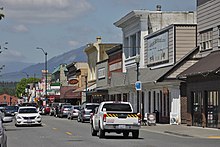The Cities Portal

A city is a human settlement of a substantial size. The term "city" has different meanings around the world and in some places the settlement can be very small. Even where the term is limited to larger settlements, there is no universally agreed definition of the lower boundary for their size. In a narrower sense, a city can be defined as a permanent and densely populated place with administratively defined boundaries whose members work primarily on non-agricultural tasks. Cities generally have extensive systems for housing, transportation, sanitation, utilities, land use, production of goods, and communication. Their density facilitates interaction between people, government organizations, and businesses, sometimes benefiting different parties in the process, such as improving the efficiency of goods and service distribution.
Historically, city dwellers have been a small proportion of humanity overall, but following two centuries of unprecedented and rapid urbanization, more than half of the world population now lives in cities, which has had profound consequences for global sustainability. Present-day cities usually form the core of larger metropolitan areas and urban areas—creating numerous commuters traveling toward city centres for employment, entertainment, and education. However, in a world of intensifying globalization, all cities are to varying degrees also connected globally beyond these regions. This increased influence means that cities also have significant influences on global issues, such as sustainable development, climate change, and global health. Because of these major influences on global issues, the international community has prioritized investment in sustainable cities through Sustainable Development Goal 11. Due to the efficiency of transportation and the smaller land consumption, dense cities hold the potential to have a smaller ecological footprint per inhabitant than more sparsely populated areas. Therefore, compact cities are often referred to as a crucial element in fighting climate change. However, this concentration can also have some significant negative consequences, such as forming urban heat islands, concentrating pollution, and stressing water supplies and other resources. (Full article...)
Selected city -
Cotabato City, officially the City of Cotabato (Maguindanaon: Kuta nu Kutawatu, Jawi: كوت نو كوتوات; Cebuano: Dakbayan sa Cotabato; Filipino: Lungsod ng Cotabato), is a first class independent component city in the Bangsamoro Autonomous Region in Muslim Mindanao, Philippines. According to the 2020 census, it has a population of 325,079 people,[1] making it as the most populated city under the independent component city status.
Cotabato City was formerly a part and the regional center of Region XII, but due to the ratification of the Bangsamoro Organic Law, it is now part of Bangsamoro and serves as the regional center. Being an independent component city, it is not a subject to regulation from the Provincial Government of Maguindanao del Norte where it is geographically located. The Philippine Statistics Authority also lists Cotabato City as statistically independent. It was the capital of the Sultanate of Maguindanao. (Full article...)
Did you know -
- ... that in 1976, William F. Matthews became the first bookbinder to receive the Insignia Award of the City and Guilds of London Institute?
- ... that Broadway's Imperial Theatre, opened in 1924, was the Shubert family's 50th theater in New York City?
- ... that New York City's Broadhurst, Plymouth, Shubert, and Booth Theatres were all designed with curved corners facing Broadway?
- ... that Village East by Angelika is the only remaining Yiddish theater building in what was once the center of New York City's Yiddish Theatre District?
- ... that the heiress Gertrude Rhinelander Waldo abandoned a brand-new mansion in New York City and refused to sell, rent, or maintain it?
- ... that New York City's Lexington Hotel banned tipping when it opened?
Related portals
Related WikiProjects
Arlington is a city in northern Snohomish County, Washington, United States, part of the Seattle metropolitan area. The city lies on the Stillaguamish River in the western foothills of the Cascade Range, adjacent to the city of Marysville. It is approximately 10 miles (16 km) north of Everett, the county seat, and 40 miles (64 km) north of Seattle, the state's largest city. As of the 2020 U.S. census, Arlington had a population of 19,868; its estimated population is 20,075 as of 2021.
The city lies in the traditional territory of the Stillaguamish people, an indigenous Coast Salish group. Arlington was established in the 1880s by settlers and the area was platted as two towns, Arlington and Haller City. Haller City was absorbed by the larger Arlington, which was incorporated as a city in 1903. During the Great Depression of the 1930s, the Arlington area was the site of major projects undertaken for employment under the direction of federal relief agencies, including construction of a municipal airport that would serve as a naval air station during World War II. Arlington began suburbanizing in the 1980s, growing by more than 450 percent by 2000 and annexing the unincorporated area of Smokey Point to the southwest. (Full article...)
Selected article -
A direct-administered municipality (直辖市; Zhíxiáshì; 'direct-administered city'; commonly known as municipality) is a city of China that is directly affiliated with the central government and is not placed under any provinces. There are four municipalities in China: Beijing, Chongqing, Shanghai, and Tianjin.
Although being as a city by name, a Chinese municipality is more than a city in a traditional sense. It is equivalent to a province as it usually composed of a central urban area and a number of much larger surrounding suburban and rural areas. (Full article...)
General images -
Topics
List articles
Subcategories
Associated Wikimedia
The following Wikimedia Foundation sister projects provide more on this subject:
-
Commons
Free media repository -
Wikibooks
Free textbooks and manuals -
Wikidata
Free knowledge base -
Wikinews
Free-content news -
Wikiquote
Collection of quotations -
Wikisource
Free-content library -
Wikiversity
Free learning tools -
Wiktionary
Dictionary and thesaurus
- ^ Census of Population (2020). "Region XII (Soccsksargen)". Total Population by Province, City, Municipality and Barangay. Philippine Statistics Authority. Retrieved 8 July 2021.








































